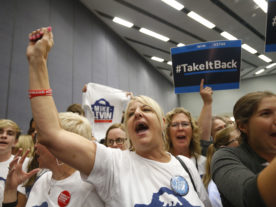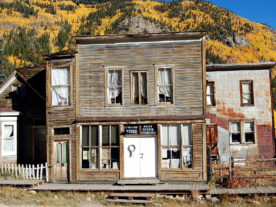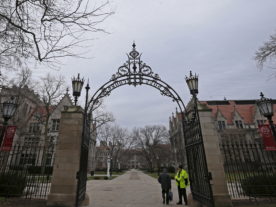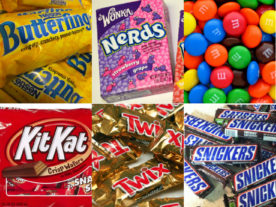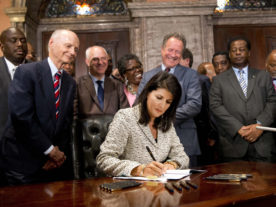
A white Toyota RAV4 gleams at the Washington Car Show on Jan. 28, 2016. White is the most popular auto color in the United States and abroad. (C. Guensburg/VOA)
With its arresting orange exterior, the Chevrolet Trax lured Kyra Taylor and Phillip Akinola like moths to a flame.
“It’s pretty. It would be easy to spot the car in a parking lot,” said Taylor, as she and her fiancé examined the small SUV at a recent auto show in Washington. But the Maryland couple, scouting for a vehicle suited to transporting baby daughter Aria, sounded uncertain about the bold hue.
“My colors are black and silver,” said Akinola, who owns a silver Ford Escape SUV.
When it comes to car colors, Americans may dream in Technicolor but most drive in neutral. Despite the fiery reds, brilliant blues and lively greens recently found in exhibition halls and dealer showrooms, almost 75 percent of new cars sold in the United States in the most recent model year came in conservative hues: white, black, silver and gray.

A vibrant orange Chevrolet Trax SUV attracts Phillip Akinola and his fiancee, Kyra Taylor, sitting in the driver’s seat with their baby daughter at the Washington Auto Show, Jan. 28, 2016. The family, from Largo, Md., generally steers toward more conservative car colors. (C. Guensburg/VOA)
Staid selections reflect a certain pragmatism.
“People have gotten practical. An off-white or silver or light brown doesn’t show dirt as much” and requires less washing, said Les Jackson, a Washington-based automotive journalist who was at the auto show. He noted costly car washes or water restrictions in drought areas as other considerations.
Also, “white vehicles tend to hold their resale value,” observed Dan Benton, color marketing manager for Axalta, a Pennsylvania-based manufacturer of liquid and powder coatings used by international automakers.
A car already ranks as a major consumer expense. The average U.S. transaction price for a new family vehicle reached $34,023 last fall, up $458 or 1.4 percent from the previous year, Kelley Blue Book analysts found.
Internationally, the neutral picture isn’t all that different from the United States scene.
“White really jumped” in 2015, accounting for more than one-third of vehicles sold and dominating in North and South America as well as Europe and Asia, said Jane Harrington, PPG Industries’ manager of color styling and automotive products. Based in Pittsburgh, Pennsylvania, the company makes paints and coatings used in car manufacturing globally.
Harrington said the results were skewed by China, where, she was told, consumers say white makes a small car look bigger. Also, “for a lot of the young people, it’s considered fresh or futuristic looking. It’s fashionable.”
 Whites and pastels “reflect more UV radiation from the sun in comparison to darker, more saturated colors. So it stands to reason that warmer climates with more intense sunlight would prefer lighter colors that absorb less energy,” Axalta’s Benton wrote in an email.
Whites and pastels “reflect more UV radiation from the sun in comparison to darker, more saturated colors. So it stands to reason that warmer climates with more intense sunlight would prefer lighter colors that absorb less energy,” Axalta’s Benton wrote in an email.
Another variable could be at play in color selection, Benton said. He cited research by Australia’s Monash University that suggests there’s a lower crash risk during daylight hours for white cars compared with darker ones.
“So white might be the color of choice for more conservative drivers,” he said.
Both PPG and Axalta report the lesser, but growing, popularity of supersaturated hues, achieved through multiple layers and clear coatings enhanced with mica, glass flake or other ingredients.
“I love looking at the concept vehicles, because that’s a great indicator of what may be coming in our future,” Harrington said.
She cited the Buick Avista, introduced in a chromatic blue that glows like a sapphire from one angle and deepens to black from another. It won the EyesOn Award for best concept car, but Buick has no plans to produce the car, a spokesman told VOA in an email.

The Buick Avista in a chromatic blue that glows from one angle and deepens to black from another. (Photo ©General Motors)
Blue, in various shades, has been coming on strong in the United States and globally. It accounted for 8 percent of North American auto sales, Axalta said in its most recent color popularity report.
But, among bold car colors, red is the most popular in North America, accounting for 11 percent of the market, Axalta found. Only South America comes close to that level of enthusiasm, with red representing 10 percent of its sales.
Elsewhere on the spectrum, green’s popularity has declined.
“In the mid-1990s, green was the most popular color in North America,” Benton said. “Today, green is hard to find.”
Almost three out of five consumers say color affects car-buying decisions. They want the option of bold color even if they don’t exercise it, Harrington said, citing PPG research.
“Do people really buy their car color because it’s a reflection of who they are or who they would like to be? The answer is yes to both of those,” added Leatrice Eiseman, executive director for the Pantone Color Institute.
In The Color Answer Book (2003), she decoded what a car’s color says about its owner:
Vibrant red: Sexy, speedy, high-energy and dynamic
Deep blue-red: Some of the same qualities, but far less obvious
Orange: Fun-loving, talkative, fickle and trendy
Sunshine yellow: Sunny disposition, joyful and young-at-heart
Yellow-gold: Intelligent, warm, loves comfort and will pay for it
Dark green: Traditional, trustworthy, well balanced
Dark blue: Credible, confident, dependable
Light to mid blue: Cool, calm, faithful, quiet
White: Fastidious
Black: Empowered, loves elegance
Silver: Elegant, loves futuristic looks, cool
Taupe: Timeless, basic and simple tastes
Deep brown: Down-to-earth, no-nonsense
Car buyers eventually might not even need to choose a particular color.
“We have seen so many exciting developments because of technology,” Eiseman said. “One day, humans will have the ability to be chameleons.”
That could be the case with cars, too.
More About America
Is US Losing Its Innovation Edge?
More Than One-Third of Top US Innovators Are Immigrants
Americans Work More Than Just About Anyone
This Map Shows Where US Job Market Is Booming
Most US Wealth Concentrated in These 10 Areas


